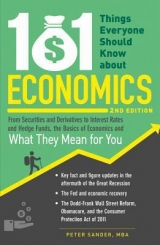
Текст книги "101 Things Everyone Should Know about Economics: From Securities and Derivatives to Interest Rates and Hedge Funds, the Basics of Economics and What They Mean for You"
Автор книги: Peter Sander
Жанры:
Экономика
,сообщить о нарушении
Текущая страница: 1 (всего у книги 14 страниц)
101 Things Everyone Should Know about Economics
2ND EDITION
From Securities and Derivatives to Interest Rates and Hedge Funds, the Basics of Economics and What They Mean for You
Peter Sander, MBA

AVON, MASSACHUSETTS
DEDICATION
101 Things Everyone Should Know about Economics, 2nd Edition is dedicated to you who are in charge of your finances today—or will be someday—who strive to make sense of the complex economic world around you. You want to understand how it all affects you, your family, and your future; you seek what you should know and why you should know it. This edition in particular is dedicated to making sense of the dismal years of the Great Recession, to learning its lessons, and to doing well for yourself and your family regardless of the current economic climate.
Contents
INTRODUCTION
CHAPTER 1:
The Basics
CHAPTER 2:
Economy and Economic Cycles
1. INCOME
2. CONSUMPTION
3. SAVING AND INVESTMENT
4. GROSS DOMESTIC PRODUCT (GDP)
5. UNEMPLOYMENT AND UNEMPLOYMENT RATES
6. RECESSIONS
7. DEPRESSIONS
8. BUSINESS CYCLE
9. DELEVERAGING
10. MISERY INDEX
11. CONSUMER CONFIDENCE
12. PRODUCTIVITY
13. ECONOMIC INDICATORS
14. DISTRIBUTION OF INCOME AND WEALTH
15. THE WEALTH EFFECT
CHAPTER 3:
Money, Prices, and Interest Rates
16. MONEY
17. MONEY SUPPLY
18. INFLATION
19. DEFLATION
20. STAGFLATION
21. INTEREST RATES
22. PRIME RATE
23. YIELD CURVE
24. RISK PREMIUM
25. BOND PRICES VERSUS INTEREST RATES
26. GOLD STANDARD
CHAPTER 4:
Banks and Central Banking
27. COMMERCIAL BANK
28. INVESTMENT BANK
29. CENTRAL BANK
30. FEDERAL RESERVE
31. TARGET INTEREST RATES
32. FED OPEN MARKET OPERATIONS
33. FRACTIONAL RESERVE BANKING
34. REFLATION
35. PARADOX OF THRIFT
36. RESERVE REQUIREMENTS
37. LOAN LOSS RESERVE
38. TIER 1 CAPITAL
39. DODD-FRANK WALL STREET REFORM AND CONSUMER PROTECTION ACT OF 2010
CHAPTER 5:
Government and Government Programs
40. U.S. TREASURY
41. FEDERAL BUDGET
42. FEDERAL DEFICITS AND DEBT
43. SECURITIES ACTS OF 1933, 1934, AND 1940
44. SECURITIES AND EXCHANGE COMMISSION (SEC)
45. FEDERAL DEPOSIT INSURANCE CORPORATION (FDIC)
46. GOVERNMENT-SPONSORED ENTERPRISES (GSES)
47. TAX POLICY AND INCOME TAXATION
48. CREDIT PROTECTION
49. BANKRUPTCY LAW
50. ENTITLEMENTS: SOCIAL SECURITY AND MEDICARE
51. RETIREMENT PLANS
52. UNEMPLOYMENT BENEFITS
53. HEALTH INSURANCE PROTECTION: COBRA AND HIPAA
54. OBAMACARE
CHAPTER 6:
Economic Schools and Tools
55. FISCAL POLICY
56. MONETARY POLICY
57. KEYNESIAN SCHOOL
58. CHICAGO OR MONETARIST SCHOOL
59. AUSTRIAN SCHOOL
60. SUPPLY-SIDE ECONOMICS
61. TRICKLE-DOWN ECONOMICS
62. REAGANOMICS
63. BEHAVIORAL ECONOMICS
64. NEW DEAL
65. PLANNED ECONOMY/SOCIALISM
CHAPTER 7:
Finance and Financial Markets
66. DERIVATIVES AND DERIVATIVE TRADING
67. ASSET-BACKED SECURITY
68. COLLATERALIZED DEBT OBLIGATION (CDO)
69. CREDIT DEFAULT SWAP (CDS)
70. MUTUAL FUND
71. EXCHANGE-TRADED FUND (ETF)
72. HEDGE FUND
73. PRIVATE EQUITY
74. LEVERAGED BUYOUT (LBO)
75. INSTITUTIONAL INVESTORS
76. MONEY MARKET FUND
77. CREDIT RATING AGENCY
78. STOCKS, STOCK MARKETS, AND STOCK EXCHANGES
79. BONDS AND BOND MARKETS
80. COMMODITIES, FUTURES, AND FUTURES MARKETS
81. CURRENCY MARKETS/FOREX
82. BROKERS, BROKER DEALERS, AND REGISTERED INVESTMENT ADVISERS
83. FINANCIAL ADVISERS
84. ELECTRONIC AND HIGH-FREQUENCY TRADING
85. INSIDER TRADING
86. MARGIN AND BUYING ON MARGIN
87. SHORT SELLING
88. MEDIAN HOME PRICE
89. HOUSING AFFORDABILITY
90. FORECLOSURE/SHORT SALE
CHAPTER 8:
Trade and International Economics
91. GLOBALIZATION
92. CURRENCY POLICY AND EXCHANGE RATES
93. CURRENCY DEVALUATION AND DEPRECIATION
94. FOREIGN DIRECT INVESTMENT
95. BALANCE OF TRADE
96. BALANCE OF PAYMENTS AND CURRENT ACCOUNT
97. TRADE AGREEMENTS
98. PROTECTIONISM
99. INTERNATIONAL MONETARY FUND (IMF) AND WORLD BANK
100. WORLD TRADE ORGANIZATION
101. G8 ECONOMIC SUMMITS
COPYRIGHT
Introduction
What is the world coming to?
You read the headlines. Two appeared recently on the front page of the same newspaper (for those of you who still read newspapers)or your favorite news portal:
Public Wary of Deficit, Economic Intervention
Historic Overhaul of Finance Rules
The public is wary of the deficit and economic intervention? I’m part of the public, so I guess I had better be wary too. And a big change in the rules? Better keep up with that one too. I earn, save, borrow, spend, and invest money, so I’d better find out about any changes in the rules.
Truth is, headlines like this have become part of daily life. Sure, a few years ago, headlines about GDP growth or trade deficits or interest rates were mostly background noise, to be ignored unless you were an economist. Things were going pretty well. We had money to spend, everything was growing just a little each year, our retirement accounts were growing steadily, our jobs were reasonably safe …
And then it happened.
It is the Great Recession, the economic crisis—that big crisis of 2008–2009, the effects of which have lasted well into 2013, after years of good times. Good times? Not for everyone, but for a lot of us. During those times (remember when?) our homes earned more than we did. Those of us who earned any income at all—and most retirees—could borrow money cheaply and almost without any questions asked. We used our homes as ATMs. We could buy anything we wanted, and who cared about the debt, or deficits, or inflation? That was covered too, because home prices and other investment prices were going up. But it all went “poof” starting in 2007. The speeding locomotive of real estate prices, supported by lax lending practices, suddenly went into reverse.
Much to our surprise, everything turned out to be connected to everything else. The rest is history. And it’s a history that continues to play out, and will play out for years to come.
Some of you may have taken that boring, senior-level “Econ” class in high school. You may have a rudimentary understanding of economics from that or some other class or from an uncle or grandparent who got a kick out of telling you about growing up as a kid during the Great Depression. You may have learned something along the way about supply and demand. You understood the difference between macroeconomics and microeconomics. You know that a good economy means a strong GDP and low unemployment. You have an idea that when those things are going well, you’re more likely to have some spending money in your wallet and that your 401(k) and other retirement plans will grow at least a bit. You know enough to fear inflation and that someday—inevitably—there will be yet another recession, who knows when or why. But that’s about it.
Now those relatively basic economic concepts have been set upon their ear. During the Great Recession, those news flashes were about “deleveraging,” “deflation,” “credit default swaps,” “asset-backed securities,” “hedge funds,” and “globalization.” I think we’d all agree—these were alarming words to hear even as we heard them day in and day out. As the economy jerked into reverse, we had the “impossible” collapse of big names like Bear Stearns and Lehman Brothers and the near-collapse of the banking system itself, with threats of twenty-dollar bills being no longer available in your local ATM machine. We got “medicine” in the form of unprecedented federal bailouts—the so-called “TARP” bailout of $700 billion given to all those “too big to fail” lending institutions (almost all of which has been paid back, by the way). Even as the economy mends, the Federal Reserve chairman Ben Bernanke and his equivalents at the European and Japanese central banks continue to do what’s possible to stimulate their economies, although now the news is about “tapering”—that is, in plain English, reducing—these efforts. Our president and other world leaders talk about the economy constantly—good news or bad. No doubt, it’s a complex, interconnected, and fast-paced world of change.
Before the Great Recession, the powers that be at the Federal Reserve, the SEC, and elsewhere for many years seemed to have control over things—if the economy went a little cool, they could stimulate it back to life; when it ran a little hot, they could cool it. They spoke of the “Goldilocks economy”—not too hot, not too cold. The medicine worked. Everyone expected it to work. However, in the past ten years, and especially during the crisis years of the Great Recession, the patient became less responsive to the usual medicine. So what’s the good doctor to do? Increase the dosage, naturally. That meant lower interest rates and greater financial stimulus for longer periods of time. As of mid-2013, the Fed was still injecting $85 billion a month into the economy through bond purchases, keeping interest rates artificially low in an end-run effort to stimulate the economy and employment. Unfortunately, the “side effects”—the unintended consequences—could include a bond bubble or another real estate bubble, and many are worried today about catching a deadly inflationary virus as we move forward. Too, the stock market has advanced to new all-time highs anticipating the recovery, but how much of this recovery is “real” versus a response to artificial stimulus, that is, printing money? We may have solved some of the problems and dealt with some of the tough questions, but there is still a lot more to deal with.
Bottom line: It seems as if the more you know, the more you don’t know, and since this stuff messes with your future, you’d better learn what’s going on. So that’s why the second edition of 101 Things Everyone Should Know about Economics comes to the table once again at just the right time.
This book is not a crash course on economics, although some may decide to use it that way. Most definitely it isn’t a textbook. Instead, it is intended to provide a handy reference to the very real concepts and terms in use in today’s economy. It connects things you read about and hear about to things you need to know about and do. Or not do. It’s more than a study guide for your economic life. It is intended to help you understand how economic concepts affect you. It is intended to help you make sense of what is good for you and bad for you, both now and in the future. It is intended to help you ask the right questions and ultimately take the right actions.
By no means is this book, like so many other books and articles you read, designed to help you get rich or earn more money or even save money. And, very importantly, this guide is not meant to help you understand just today’s economy and its opportunities and pitfalls. This book is meant to help you be more knowledgeable, more aware, and more prepared going forward. Prepared to recognize the next crisis. Prepared to deal with it. Prepared to come out better than you did the last time. Prepared to come out better than you otherwise would have.
That preparation is important. Today’s schools turn out graduates at all levels prepared to handle a career, perhaps multiple careers. But they still don’t—much to our detriment—offer preparation for economic life. Even the “home economics” courses of the 1950s are gone; there is virtually nothing to help you live prudently or efficiently or economically, save for the vast assortment of books and magazines that tell you where to put your money this year. I believe a more basic understanding is necessary before you can trust yourself to make the right decisions. Today’s education and media leave a huge gap in that area. 101 Things Everyone Should Know about Economics, 2nd Edition is the fastest, friendliest, and most effective way to fill the gap.
THE ECONOMY IN SEVEN STEPS
Whether it’s a book or a business presentation, I believe any complex topic can be broken down into between three and seven important pieces. That principle applies to this edition, as well as the first. The first chapter acts a refresher to common economic terms and then the remaining seven discuss the 101 economic concepts. I describe the concept, fast facts, what you should know, and why you should care about it. Common sense, start to finish. Beyond the first chapter, here is how the book is laid out:
Chapter 2: Economy and Economic Cycles. A look at the economy as a whole as well as its current condition. This chapter offers a little bit of history, with special focus on the ups and downs, the booms and busts, why they happen, and how they affect you.
Chapter 3: Money, Prices, and Interest Rates. What money is, what it does, and what happens to it, including inflation, deflation, and stagflation, and the cost of money—interest rates and the dynamics around them.
Chapter 4: Banks and Central Banking. Once we understand money, it’s time to learn about banks—the different kinds of banks and how the banking system works, with special emphasis on the Federal Reserve and its relationship to the banks and the economy at large.
Chapter 5: Government and Government Programs. With the basic system outlined, who are the big government players in the economy, and what do they do? What are the most important laws and policies, why are they there, and how do they affect us?
Chapter 6: Economic Schools and Tools. From government and government policy, we take another step toward the “big picture.” What are the major schools of thought for managing or guiding the economy? How do they work? How do they explain what has happened, what should happen, or what’s going to happen with our economy?
Chapter 7: Finance and Financial Markets. The first six chapters covered the “macro” world. But what about all those things that happened on Wall Street that got us into trouble? Yes, there are hundreds of books about the stock market and Wall Street. But do they explain how Wall Street concepts connect to the larger economy? Do they explain “collateralized debt obligations” in plain English? And what you need to know about the financial markets and “retail” financial people like broker-dealers and financial advisers? And what about all those terms you see daily about real estate? Is a stock market short sale the same as a real estate short sale? This chapter explains the most important financial markets and instruments of today.
Chapter 8: Trade and International Economics. What is globalization, and how will it affect you? What makes the dollar gain against the euro, or vice versa? And what about those trade deficits? How does (and should) foreign trade work in a “new” economy? And how will that affect your job, the cost of living, and your life?
In the nineteenth century, the historian Thomas Carlyle was the first to refer to economics as “the dismal science.” (To be fair, Carlyle wasn’t exactly a bundle of laughs himself.) Since then, economics has labored under the burden of descriptions like “boring,” “complicated,” and “dry.”
It doesn’t have to be that way, and I hope this book will convince you otherwise. Economics is about the most basic human activities: what we produce, how we produce it, and how we consume it. It’s concerned, in other words, with human behavior—in fact, in recent years the field of behavioral economics has risen to prominence because of best-selling books like Freakonomics, The Black Swan, and Predictably Irrational.
In this book, we’re interested in what different economic terms and concepts mean, and how they affect us. So, to rather freely adapt a phrase made popular in the movies: read on and prosper.
CHAPTER 1
The Basics
If you have taken an introductory economics course in college or have read a basic economics textbook, you can probably skip this chapter and go right to the next one. But if you want to refresh your grasp of basic economic terms, read on. Feel free, as you go through this book, to flip back to this chapter if you get confused by some of the terminology.
A GLOSSARY OF BASIC ECONOMIC TERMS
Asset. Something that is owned. For businesses, it can take the form of things such as factories, products, and equipment. Assets can also be intangibles such as patents, trademarks, and copyrights. These kinds of things often fall into the category of intellectual property, a concept that’s the subject of a growing body of law. In the age of the Internet, determining the value of an intangible asset has grown very complicated, and is probably going to become more so in the future.
Broker. Someone who sells or buys things on behalf of other people. For example, a mortgage broker buys and sells mortgages. An insurance broker arranges the sale of insurance policies to clients, and so on. The term brokerage firm usually refers to a company that deals in stocks. Brokers often make recommendations to their clients about what to buy and sell, but ultimately the buy-or-sell decision rests with the client.
Capital. Originally, this word described one of the factors used to produce goods (the others included things like land and labor). In today’s economy, “capital” generally refers to cash as well as to material goods like manufacturing equipment, tools, and so on. The term financial capital is used when talking about the monetary resources entrepreneurs use to create their products or services.
Competitive Advantage. It’s the nature of capitalism that businesses compete against one another. Each one tries to find some special way of beating its rivals, something that makes it stand out. That something is competitive advantage (also sometimes called the competitive edge). This is one of the most valuable tools a company has to ensure its growth, and companies try to protect their competitive advantages from all rivals.
Consumer. Anyone who uses goods and services that companies produce. Consumers have become a major driving force in the U.S. economy, and companies compete fiercely for their business. To this end, they spend a lot of time analyzing consumers, trying to figure out their buying patterns, their psychology, and so on.
Credit. Money that’s loaned to someone or something. Credit can be in the form of a mortgage, a car loan, a line of credit through a credit card, or any one of numerous other forms. When you have credit, that’s money that has been loaned to you by someone else. If you’re a creditor, you’ve loaned money to someone, and they’ll have to pay it back to you, usually with interest.
Debt. Something you owe to someone else. Personal debt has become a huge issue in the United States in recent years, and many people, as a result of their exploding debt, have suffered bankruptcies and foreclosures. However, some debt can be good—for example, if it’s used to buy something that will produce value (like a business asset) or increase in value over time (like certain real estate investments), or something that you need but will cost more in the future. Bad debt is when you purchase something you don’t need and can’t afford.
Elasticity. In the context of economics, the measure of the ability of an economy to change rapidly in response to circumstances. In a more technical sense, it’s the ratio between the percentage change in two variables (for example, supply and price). For instance, if the price of a product rises slightly and immediately the demand for it falls dramatically, the product is said to have high elasticity. The price of a product such as gasoline, on the other hand, can rise quite a lot before demand drops substantially, so it’s said to have low elasticity.
Entrepreneur. Someone who starts a business and takes responsibility for its success or failure. The term has also come to mean someone who shows enterprise, initiative, and daring in the business community. Even though many new businesses fail, we still respect those who are brave enough to follow their dreams. Small businesses, started and operated by entrepreneurs, represent 99 percent of all U.S. businesses, and for many they represent American capitalism in its purest form.
Forecast. An estimate of where the economy, a business, or some feature of either is going. Different government agencies, as well as nongovernmental organizations, make economic forecasts, some of which can affect the performance of the markets. Businesses use forecasts to plan their goals and budgets. Keep in mind, though, that a forecast is a guess. It’s usually an educated guess, but still a guess.
Free Enterprise. An economic system in which markets and companies are privately owned and are free to compete against one another with minimal government restrictions. This is the system that exists in the United States. It’s sometimes referred to as laissez-faire capitalism or free-market capitalism.
Innovation. The process by which companies come up with new products and services. Often, companies’ research and development (R&D) divisions take the lead in driving innovation. An innovation goes beyond an “invention” in that it becomes a product or service that people will buy—that is, there’s a market for it. Some companies (for example, Apple and Google) have built their competitive advantage on innovation—often with “disruptive” innovations that really change markets, in contrast to just adding refinements to existing products or services.
Interest. The fee paid in order to use borrowed money. Essentially, this is the cost of obtaining credit. Interest is calculated as a percentage of the amount borrowed. This percentage is called the interest rate. There are many different kinds of interest, including simple interest and compound interest. Interest rates are closely tied to credit risk, which is the risk that an extended credit—that is, a loan—will not be paid. In general, at a time of high credit risk, interest rates tend to go up, since creditors want to make sure they recoup their money. However, this isn’t always the case.
Investor. Someone who puts money into a business in order to earn a return—that is, to make more money. Sometimes investors do this by loaning money to the entrepreneurs who are starting or running the business. More often, they do it by purchasing stock—an ownership stake—in the business. The basic point to keep in mind is that investors want to earn a return. The percentage of money they make in relation to their investment is called their return on investment, or “ROI.”—see “Return on Investment.”
Macroeconomics. As implied by the term “macro,” the study of economics on a large scale: regional, national, or international economic trends and issues. Macroeconomists try to figure out what drives entire economic systems, and what impact these systems have on each other.
Microeconomics. Basically the opposite of macroeconomics. Microeconomics studies economic movement on a smaller scale—for individual businesses or even on the level of individual households. Microeconomists also study the behavior of companies and regions to understand how these units are allocating their resources and responding to pressures from above and below. A microeconomist might also study the behavior of a single product or product type.
Monopoly. A single company or individual controlling an entire product or service. In the nineteenth century, monopolies were fairly common in America (Standard Oil, for example). Throughout the late nineteenth and twentieth centuries, many of them were broken up by legislation, starting with the Sherman Antitrust Act of 1890. Today, government agencies review mergers in an attempt to prevent the formation of monopolies. In recent years, several monopoly-related cases have received a great deal of attention, most famously involving Microsoft, and have also entered the conversation with major wireless carriers, the oil industry, and other mergers.
Mortgage. The security for the money you owe to a lender. When you take out a mortgage, you borrow money and give the lender an interest in a property to secure the repayment of the debt. When you’ve satisfied the terms of the mortgage (that is, when you’ve paid the debt), the interest of the lender in your property will be returned to you. If you don’t repay the debt, the lender can foreclose on the property.
Outsourcing. The increasingly common practice of contracting people outside an organization to perform work that used to be done by people within a company. Outsourcing has grown massively to include everything from call centers and customer service to information technology services. Many American companies are outsourcing overseas to countries such as India, China, and Mexico, where labor costs and other costs of doing business are lower.
Publicly Held Company. A company that’s registered with the Securities and Exchange Commission and whose stock is traded on the open market, where it can be bought and sold by the public. In a privately held company, on the other hand, stock is held by a relatively small number of shareholders, who don’t trade it openly. Often these are family or friends of the owner. Eventually, the company may hold an initial public offering (IPO) and issue stock shares on the open market. After the company registers with the SEC, it becomes a public company.
Productivity. A measure of efficiency. It’s often expressed as the ratio of units to labor hours (a company produces two thousand pairs of shoes per hour, for example). Productivity is one element that’s factored into studies of economic growth. In general, industries try to increase productivity through technological innovation and other methods.
Profit Margin. A company’s net income divided by sales. It’s a basic measure of profitability, one that companies look at closely each year. Companies also look at metrics like revenue, but they aren’t considered as significant as profit margin. After all, a company can increase its revenue by selling more products, but if the production costs increase (for example, because of a rise in the price of raw materials or labor), the company isn’t really making any more money.
Return on Investment. A measure of how much money an investor gets back relative to the amount invested. It’s sometimes called the rate of return or the rate of profit. Many people make decisions about investment or other financial activities based on their calculation of ROI.
Venture Capital. Money that’s put into new businesses by outside investors. Venture capitalists tend to look for high-potential startup companies that can grow quickly and provide a strong return on investment. Family and friends who lend money for startups are sometimes referred to as angel capital. In some cases, venture capitalists anticipate that the company will grow to a certain stage and then be sold for a profit, and they’ll reap a rich reward. Alternately, the company may be successful in its initial public offering and see its stock rise dramatically in value. Many large companies such as Google and more recently Facebook started out this way.








